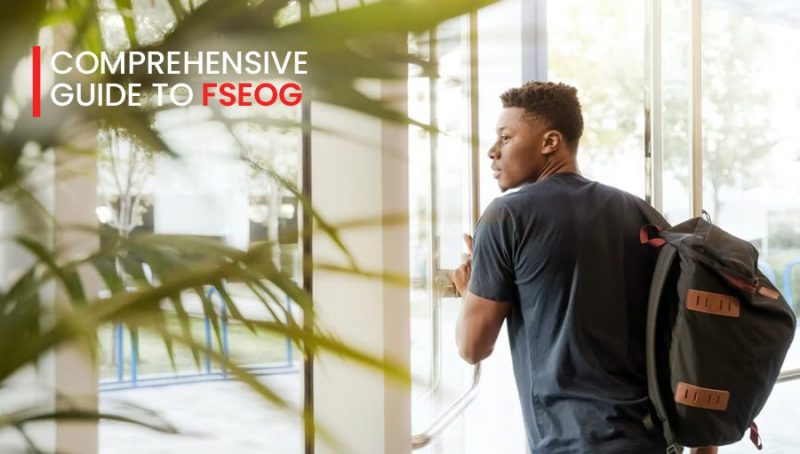Similar to federal grants for supporting low-income families with health, and nutritional needs, Federal Supplemental Educational Opportunity Grants is a fund for college students in urgent need of financial support to attend school. It is popularly known as FSEOG. This program supports students who are fresh out of high school and need support to continue education and enroll in undergraduate courses. One does not need to repay the fund received under the program.
This program is directly administered by the financial aid office of the participating institution. It should be mentioned here that not all institutes participate. Check with your school’s financial aid office to know if it participates in the program. If it does and you meet the eligibility criteria you can get the fund.
The fund is provided by the U.S. Department of Education’s Office of Federal Student Aid. Institutes provide the funds to eligible students following all federal guidelines. Each participating school receives a certain amount of FSEOG funds from the U.S. Department of Education’s Federal Student Aid office each year. Usually, 75% of the fund is provided by the federal government. The participating institutes add up the rest. There is no guarantee that all eligible students will receive the benefit. Since funds are limited, institutes cannot provide the benefit to all the applicants. Also, the money provided by the Government may vary every year.
Who Can Apply for FSEOG?

Every student cannot qualify to apply for FSEOG. Undergraduate students who need financial assistance in education and meet the eligibility criteria can apply for the program. A person is eligible for FSEOG if: He or she is a citizen of the United States; is a full-time student; have a completed FAFSA (Free Application for Federal Student Aid) form; is not in default of any federal student loan; does not have a Federal Pell Grant overpayment; has a valid Social Security Number; and has a high school diploma or a General Education Development (GED) Certificate.
While these are the criterion set by the Federal Government, there are some additional requirements that differ from institute to institute. To qualify, a student must meet both sets of requirements.
How to Apply?
If you are interested in applying for the program, the first thing you should do is fill out the Free Application for Federal Student Aid (FAFSA) form. You can do it online. Your eligibility is also based on the answers on your FAFSA form. The FAFSA form is designed to find out the Expected Family Contribution (EFC) number of the applicants. The institute can determine your financial need with this form. Students with the lowest Expected Family Contributions (EFCs) who also receive Federal Pell Grants are given priority over the other students.
A student who qualifies for the grant will receive the fund in the student account or directly from the school. You will be notified of your application via email. Every qualifying student will receive the fund once every term (semester, trimester, or quarter). Schools that do not use semesters, trimesters, or quarters must disburse funds at least twice per academic year. Sometimes, the fund that the student qualifies for exceeds the tuition fee and other expenses. In that case, your institution will deposit the difference in your bank account or you will get a cheque.
The federal grant range from $100 to $4000 a year. Since this grant is given every semester, qualifying students usually get $500 per semester. The amount of money each student gets depends on the student’s financial condition, other federal funds or financial support he/she receives, the time of your application, and the amount of fund available in the institute.
While the Federal Pell Grant Program provides every eligible student with the fund, it is different for FSEOG. Once the full amount of the fund is given away to the qualifying students, no students will qualify to get the fund for the same year. You can either visit the official FSEOG website to know the deadlines or contact the financial aid office of your school or the school’s official website. Finish your FAFSA form by the deadline since limited funds are available. If the fund is over, then that’s it for the year, no additional funds are given.
There are certain cases when one needs to repay the grant. In case you need to repay it, your school will notify you of it. You can mutually decide on a repayment arrangement. Usually, you need to repay the entire amount in 45 days or at least give back a certain amount.
You will need to repay the amount in any of the following cases: You left the program for which you received the grant early; Your enrollment status changed, reducing your eligibility for your grant (for instance, if you switch from full-time enrollment to part-time, your grant amount will be reduced); You received outside scholarships or assistance that reduced your need for federal student aid.
To continue receiving the grant, you should maintain your registration as an undergraduate student and attend classes regularly. You should not have earned a bachelor’s degree before. Also, visit the financial aid office of your school in case your family’s financial situation change.
How to Contact
For more information on the program, interested applicants may contact the Federal Student Aid Information Center at 800-433-3243 or 800-4FED-AID. You can also send an email to customerservice@studentaid.gov. The mailing address is: PO Box 1854, Monticello, KY 42633.

